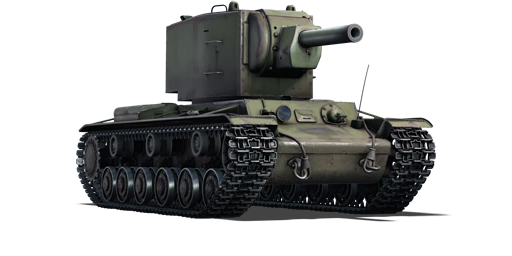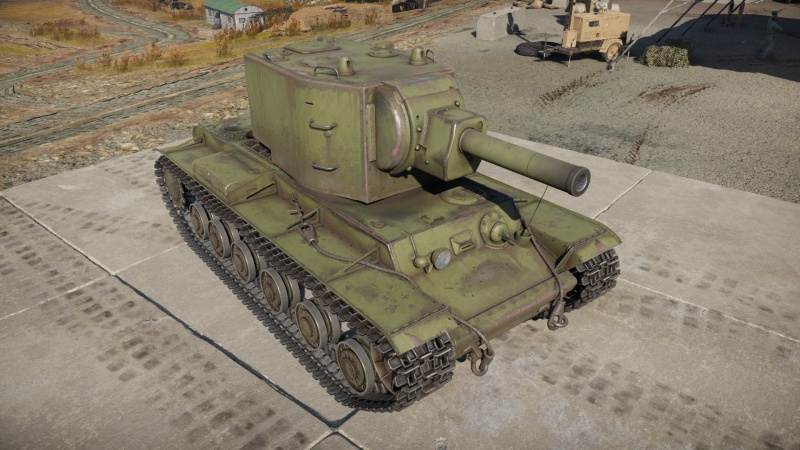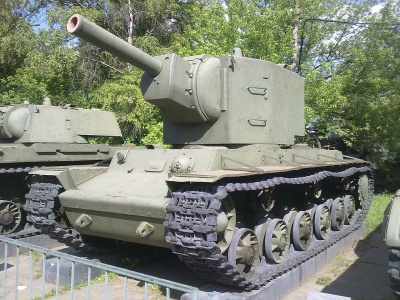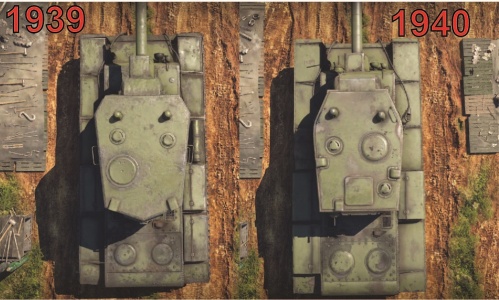KV-2 (1940)
| This page is about the heavy tank KV-2 (1940). For other versions, see KV-2 (Family). |
Contents
Description
The KV-2 (1940) is a premium gift rank III Soviet heavy tank with a battle rating of 3.7 (AB/RB/SB). It was introduced during the Closed Beta Test for Ground Forces before Update 1.41. The KV-2 (1940) was a reward vehicle for the 2016 WW2 Chronicles and the 2017 Festive Quest events.
One of the most infamous tanks in the Soviet tree, the KV-2 introduces the concept of heavy-calibre armaments that will trend on in the Soviet heavy tank.
The KV-2 is a modification of the KV-1 that mounted a 152 mm howitzer in order to provide support to infantry against fortified positions. The large heavy turret, necessary to mount the 152 mm howitzer, results in a slow traverse time. Its gun is an effective breach weapon, designed to be used against fortifications. Despite effective usage, very few were made, with the majority being lost due to breakdowns.
The KV-2 is a behemoth of a tank, which players feared due to the mighty punch of its 152 mm round and its distinctive profile. However, these traits also serve as the tank's weaknesses. While the KV-2 can still be an effective force on the battlefield, it is currently outperformed by nearly all other Soviet vehicles.
This KV-2 behemoth is also referred to by the following nicknames: the barn, King of Derp, the fridge, Tsar Bomba.
General info
Survivability and armour
The large turret housing the 152 mm howitzer is a huge target on the KV-2, a more enticing target than the hull. The profile makes concealing the tall heavy tank difficult, while the turret armour is relatively poor all-around at 75 mm. Not to mention that there will always be ammunition inside the turret, so a penetrating APHE shot have a very high chance of detonating one of these ammunition. At its battle rating, most enemy tanks have the capability of penetrating and eliminating the KV-2 through the turret, not to mention even some of the lower rank ones have powerful enough guns to deal with the armour. The normal role of a heavy tank is to bring armour and firepower to support the lighter, faster tanks to hold strategic points they have captured. However, the massive profile of this tank and majority of flat 75 mm armour means that even with proper angling and cover, the KV-2 will be unable to hold points for long. The KV-2 is easily identified by even the least experienced players and as soon as it fires one round, it will be out-manoeuvred on and forced to retreat or be violently removed. Additionally, artillery and aircraft will often force the KV-2 out of positions if not outright destroy it due to the KV's abysmal speed and massive size. Lastly, the KV-2 has no machine gun to deal with air or light armoured targets, meaning once the howitzer fires, that is it for around 30 seconds. Even most anti-air vehicles can effortlessly overrun and destroy the KV-2 if it is over-extended or alone. Couple that with this tank's inability to provide effective long range support and players will have a difficult time finding their niche with this vehicle.
Armour type:
- Rolled homogeneous armour
| Armour | Front | Sides | Rear | Roof |
|---|---|---|---|---|
| Hull | 75 mm (30°) Front plate 70 mm (70°) Front glacis 75 mm (26-58°) Lower glacis |
75 mm | 60 mm (3-86°) Top 70 mm (11-58°) Bottom |
35 mm Front 30 mm Rear |
| Turret | 75 mm Front turret 70 + 75 mm (2-41°) Gun mantlet |
75 mm | 75 mm 45 mm (2-49°) Machine gun port |
40 mm |
Notes:
- Suspension wheels are 20 mm thick, torsion bars are 20 mm thick, and tracks are 30 mm thick.
Mobility
| Game Mode | Max Speed (km/h) | Weight (tons) | Engine power (horsepower) | Power-to-weight ratio (hp/ton) | |||
|---|---|---|---|---|---|---|---|
| Forward | Reverse | Stock | Upgraded | Stock | Upgraded | ||
| Arcade | 37 | 7 | 52.4 | 775 | 1,145 | 14.79 | 21.85 |
| Realistic | 35 | 7 | 531 | 600 | 10.13 | 11.45 | |
The KV-2 is incredible sluggish in speed and manoeuvrability. The original KV-1 is already slow as is, but the KV-2 added a huge and heavy turret that increased the total weight from ~46 tons to ~52 tons. Top speed for the vehicle on flat ground is only about 30 km/h, and accelerating is very slow to get the tank up to this speed. Unless moving forwards at a certain gear, the KV-2 is also very hard to turn on even ground.
Modifications and economy
Armaments
Main armament
The 152 mm gun is perhaps the most iconic and niche weapon in the Soviet tree. Coupled with the heavy turret, it produces a slow turret traverse to get the gun onto target. The turret also presents a narrow gun depression and elevation (-5° and 12° respectively). However, the biggest factors to consider is the ammunition for the 152 mm. Although the vaunted O-530 high-explosive rounds would be the perceived preferred round for the heavy gun, it does not do as well against the typical armour with only 54 mm of shrapnel penetration, requiring a precise hit against the enemy roof or belly armour. Even the other armour-piercing rounds, the G-530 and PB-35 SAPCBC rounds have relatively mediocre penetration for the battle rating. Firing at a relatively low velocity of ~500 m/s, the heavy rounds will be hard to lead against targets at ranges up to 500 m. After firing, the infamous long reload occur that can take up to 30 seconds even with a full crew, leaving the KV-2 vulnerable to any attacks that will more than likely cripple or destroy the KV-2.
| 152 mm M-10T | Turret rotation speed (°/s) | Reloading rate (seconds) | |||||||||||
|---|---|---|---|---|---|---|---|---|---|---|---|---|---|
| Mode | Capacity | Vertical | Horizontal | Stabilizer | Stock | Upgraded | Full | Expert | Aced | Stock | Full | Expert | Aced |
| Arcade | 36 | -5°/+12° | ±180° | N/A | 4.9 | 6.7 | 8.2 | 9.0 | 9.6 | 43.29 | 38.30 | 35.30 | 33.30 |
| Realistic | 3.6 | 4.2 | 5.1 | 5.6 | 6.0 | ||||||||
Ammunition
- G-530 (SAPCBC) - The semi armour-piercing round has the same speed as the HE shell with decent amount of penetration for nearly all rank III tanks. In ranges greater than 1,000 m, the OF-530 shell should be loaded to effectively deal with any vehicle including heavy tanks. Compared to the PB-35, it has much greater speed, improving long range accuracy especially against moving targets. This round is also free to use compared to the PB-35, so tankers who are a little low on funds can utilize this round to "stretch their lions", as despite the advantages of the PB-35, the G-530 is equally as effective against most targets that can be encountered.
- OF-530 (HE) - The high-explosive shell requires careful aim as despite its infamous power, a solid hit on the front of an enemy tank would not necessarily defeat the enemy. One must preferably aim beneath tanks or below the gun mantlet to sneak into thinly armoured portions such as the roof or belly armour.
- PB-35 (SAPCBC) - Compared to the G-530, this shell retains better penetration over range, greater effectiveness against sloped armour thanks to the ballistic cap, but a slightly lower explosive payload that use of A-IX-2 explosive compound. However, because the projectile is much heavier and it uses the same propellant charges, the speed of the projectile is much slower with a muzzle velocity of 436 m/s (975 mph) and results in a higher arc of fire downrange. While this can present a disadvantage against moving target at range, careful gunners can make use of this attribute to shoot over hills or obstacles easier then they could with the G-530.
| Penetration statistics | |||||||
|---|---|---|---|---|---|---|---|
| Ammunition | Type of warhead |
Penetration @ 0° Angle of Attack (mm) | |||||
| 10 m | 100 m | 500 m | 1,000 m | 1,500 m | 2,000 m | ||
| G-530 | SAPCBC | 69 | 68 | 64 | 60 | 56 | 52 |
| OF-530 | HE | 48 | 48 | 48 | 48 | 48 | 48 |
| PB-35 | SAPCBC | 86 | 85 | 81 | 77 | 73 | 70 |
| Shell details | ||||||||||||
|---|---|---|---|---|---|---|---|---|---|---|---|---|
| Ammunition | Type of warhead |
Velocity (m/s) |
Projectile mass (kg) |
Fuse delay (m) |
Fuse sensitivity (mm) |
Explosive mass (TNT equivalent) (kg) |
Ricochet | |||||
| 0% | 50% | 100% | ||||||||||
| G-530 | SAPCBC | 530 | 40 | 1.2 | 19 | 5.1 | 48° | 63° | 71° | |||
| OF-530 | HE | 530 | 40 | 0.3 | 0.1 | 5.82 | 79° | 80° | 81° | |||
| PB-35 | SAPCBC | 436 | 51.06 | 1.2 | 19 | 4.85 | 48° | 63° | 71° | |||
Ammo racks
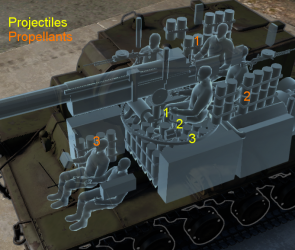
| Full ammo |
Ammo type |
1st rack empty |
2nd rack empty |
3rd rack empty |
Visual discrepancy |
|---|---|---|---|---|---|
| 36 | Projectiles Propellants |
25 (+11) 21 (+15) |
13 (+23) 9 (+27) |
1 (+35) 1 (+35) |
No |
Notes:
- The KV-2 (1940) uses two-piece ammunition, composed of projectiles (yellow) and propellant bags (orange). Both have separate racks.
- Shells are modeled individually and disappear after having been shot or loaded.
- Turret empty: 9 (+27) shells.
Machine guns
| 7.62 mm DT | ||||
|---|---|---|---|---|
| Mount | Capacity (Belt) | Fire rate | Vertical | Horizontal |
| Coaxial | 3,087 (63) | 600 | N/A | N/A |
Usage in battles
The old peek-a-boom tactics, and staying behind others is still the best method for employing this "heavy tank". Roll forward, take the shot, and then pull back for the over half-minute reload time, and then repeat. Close range brawling is a bad idea due to certain characteristics on the tank. Make sure to plan the route ahead of time make sure to avoid large distances in the open, this is a slow moving tank with a large profile making it an easy target for long barreled guns. It is recommended to work with a squad mate or other friendly tanks to cover the KV-2 during the reloading phase.
Most tanks with a high-velocity cannon can cripple the KV-2 through the turret. As such, pretty much all tanks at its battle rating should be taken account of. Rely on always getting the first shot off, else the enemy tank is more than likely to destroy the KV-2.
Another type of vehicles to worry about are the very small tanks like the M22 and the ASU-57 as these can get right under the tank's gun depression and fire away at weak points with little risk of return fire by the KV-2.
Arcade battles
In Arcade, the target lead indicator make the slow, but long range penetrating PB-35 SAPCBC a destructive force to be afraid of since ranging is a lot easier for the low-velocity shells. Always conduct attacks via "Peek-a-boo" tactic in that stay behind cover while searching for targets, then pop out when a target presents itself to fire before returning back to cover to reload.
One must be conscious and use the map terrain to their advantage. On more open maps like Karelia and Carpathians, the KV-2's speed and low velocity will make traversing the battlefield while sniping long-range targets difficult. However, one could can hang back and snipe unsuspecting and immobile targets, while at range most return fire would more then likely bounce off the armour. However, be wary of more penetrating guns like the 75 mm on the Panther and the 76 mm on the M4 Shermans that easily piece the front turret armour.
Smaller maps benefit the KV-2 in that the low shell velocities are no longer a big detriment to the combat ability, plus it could make the most of the initial penetration values in close-range battles. However, enemy tanks in close-range will also have an easier time penetrating the KV-2 front armour, or flanking around while reloading the gun. In these cases, situational awareness and friendly support is the key to victory and survival of the KV-2 in the smaller maps.
Realistic/Simulator battle
Realistic and Simulator modes are taxing for the KV-2 as the removal of the target lead indicator can make long-range fighting with the 152 mm a chore.
The most important thing in these game modes, due to the lack of target markers, is vision. The binoculars are the greatest assets. Keep the turret in a well angled position while scouting for targets with the binoculars or normal eyesight.
Since the usual fighting ranges exceed 600 m, getting hits without aim assistance with the howitzer are rare. Though close-range fighting can fix this, close-quarters battle is not a tactic the KV-2 should indulge in alone without supporting teammates to cover for the tank in case of flankers. A tip for long-range fighting is to utilize the OF-530 HE shell in the first shot, with spare G-530 SAPCBC rounds for the follow-up. These two rounds share the same ballistics, so the HE shell can be fired first to gauge the distance. If it lands close to the enemy and hits, chances are it will either destroy it or cripple its mobility, plus the impact of the explosion will alert teammates of the presence of an enemy tank at the area of firing. If the enemy tank still remains after the OF-530 shell, the next loading G-530 SAPCBC shell can follow through the same ballistic path and destroy the enemy via a penetration.
Counter-tactics
Getting close: Probably the most difficult part, if spotted a 40 kg shell will soon be on its way to ruin someone's day. Thus sneaking up, or attacking, from outside the KV-2's field of view is advised. Of course after the KV-2 has fired, a window of opportunity and hope will open up. With moving up and aiming two shots can be placed on the moving Soviet tower tank. An attack route from the side or rear is preferable, not only is it a blind spot, but the turret traverse is so awful on the KV-2 that it will not have the time to react fast enough. Just make sure to hit, or the tank will be alerted and counter-attack, and watch out for the rear MG if in a lighter vehicle.
Shooting: Targets should be the gunner (right side) to stop the loading process and the loader to reduce loading time. If shooting APHE shells, two penetrating hits will often take out the gun breech as well, stopping the reload and return fire ability entirely. The easiest way of performing these hits is via the turret ring which will always not be angled at certain parts from the front. If APHE shells hit below the side hull, it will possibly detonate the main storage of ammunition, resulting in an instant destruction. If that is not the case the gunner, commander, cannon breech, loader, and ammunition and turret ring will be damaged or wounded.
Shooting a KV-2 from the side is much easier, just one massive turret reaching into the sky. But do not shoot anywhere! The tracks will often eat shots and most KV-2 drivers are by now smart enough to not fully load up their KV-2, leaving the rear turret empty of shells.
Pros and cons
Pros:
- Huge howitzer, dealing high damage with incredible force
- Fear factor, the sight of this behemoth tends to send smaller tanks fleeing in terror
- Acceptable armour, especially for its rank
- Able to destroy higher rank tanks
- Bouncy hull and turret, the chassis may effectively absorb shots as well
- Many experienced tank drivers would dread the characteristic, map-echoing sound of the 152 mm howitzer being fired
- As is the case with all Soviet tanks armed with a 152 mm, the KV-2 can knock out any tank or tank destroyer in the game with a single HE shell to the turret or rear hull.
- Has the armour of the KV-1 which will stop most Pz.III and T-34-76 shots
- Has premium RP and SL rewards
- If a lighter vehicle is flanking the KV-2, the rear machine gun can take care of it
- Turret is smaller than the 1939 model, so it's less easier to spot and more easy to conceal
Cons:
- Long reload, resulting in difficult 1-on-1 fights since missing gives the enemy an opportunity to destroy the KV-2.
- Slow rotation speed of the turret means that flank attacks are difficult to respond to.
- Tall turret is very vulnerable from the side and difficult to hide.
- If more than 19 rounds loaded ammo racks in the side of the turret means that most penetrating shots to the side of the turret are lethal.
- A characteristic trait of Soviet tanks, the KV-2 has terrible gun depression, worse when compared to other Soviet tanks
- Driver's viewport is a juicy weak spot, easily exploitable by experienced players
- Has a tendency, although a rare but dreaded occurrence, to overshoot targets at close range when using the sights
- Large silhouette
- Rear machine gun is only effective against the lightest vehicles, and due to its position it's next to impossible to shoot down aircraft with it
History
Development
The start of the KV heavy tanks began after the heavy tank T-35 flaws came to light. Designers were ordered to draw up new designs to become the basis of a breakthrough heavy tank needed for the Soviet doctrine. This made for a tank that was heavily armoured, but not very mobile as it was to be for siege warfare. The designs offered all had heavy armour, wide tracks, and used the torsion-bar suspension. The designs were the SMK, T-100, and what would be the KV-1 tank, which was named after the then Soviet Defense Commissar Kliment Voroshilov.
During the developmental progress, the prototypes of all these heavy tanks were made and the Winter War with Finland was on its way. The Soviets sent these tanks into Finland for combat testing, to which the KV design outperform in every way with its superior armour and firepower. The armour on the KV tank was impenetrable by an tank cannon in service and most anti-tank guns as well, the 76.2 cannon also gave it a huge firepower boost compared to the usual 37 mm in use by other countries. However, the design was found to be difficult to steer, the transmission was unreliable, ergonomics was poor and vision was limited, plus with its 45 ton weight, it was a very heavy tank for its time. In truth, while formidable in power and protection, courageous crew member willing to curse the name would speak out about the trouble the KV tank really was. The main variant of production before World War II broke out was the 'KV-1 model.
KV-2
Despite its superiority on the battlefield, some observed that the KV-1's armament was not enough to destroy some of the Finnish fortifications that they encountered. For this, a request to mount a 152 mm howitzer on the KV-1 was made, and resulted in the KV-2 with its extremely large turret and an increased weight of 52 tons. The KV-2 suffered from a very high profile, low speed, and was too turret heavy. Compared to the KV-1 height of about 9 feet, the KV-2 was at 11 ft. tall. The increased weight of the tank slowed it down drastically, and the very heavy turret mixed with a low-powered traverse speed meant that the KV-2 can only traverse on level ground, as a slope would cause the turret to start turning with gravity. The combat ineffectiveness and flaws of the KV-2 came to light, and was only put on limited production due to them, resulting in only about 334 units being produced from 1939 to 1941.
Combat usage
During the opening stages of Operation Barbarossa, the KV tanks came as a huge surprise from the Germans as they had no prior intel about these tanks, resulting in a lack of capable anti-tank weapons that could destroy these tanks aside from 88 mm Flak guns. The KV-2 served alongside the KV-1 in stalling the German Offensive to Moscow. During the Battle of Raseiniai, in Lithuania, a single KV-2 was able to hold up the entire 6th Panzer Divison for a full day by firing at them from a concealed location before it ran out of ammunition, ending with about two dozen tanks destroyed.
Due to the low quantity of KV-2 produced, they didn't see much service past the opening stages of the war due to loss from attrition or mechanical failures, however 10 were still in service with the Voronezh Front on 4 July 1943 for the battle of Kursk. These were transferred to the 3rd Mech Corps on 9 July, and by 18 July only 1 was left serviceable - 5 were destroyed on 12 July, and 4 are recorded as being in repair from 13 July.[1]
Survivors
Only one KV-2 is left intact as a survivor of the war, it is housed at the Central Armed Forces Museum in Moscow.
Media
- Skins
- Images
Comparison between the 1939 and the 1940 variant
See also
- Other vehicles of similar configuration and role
External links
References
- ↑ Link, open at your own discretion! Source provided by user Stalins Organ. US Army Center for Strategy and Force Evaluation - detailed day-day analysis of formation strengths at Kursk - both sides. 12 MB PDF download
| Leningrad Kirov Plant (Ленинградский Кировский Завод) | |
|---|---|
| Medium Tanks | |
| T-28 | T-28 (1938) · T-28 · T-28E |
| T-80 | T-80B · T-80U · T-80UK · T-80BVM |
| Heavy Tanks | |
| KV-1 | KV-1 (L-11) · KV-1 (ZiS-5) · KV-1E · KV-1S |
| KV-2 | KV-2 (1939) · KV-2 (1940) · KV-2 (ZiS-6) |
| Other | SMK · KV-220 · IS-7 · Object 279 |
| Captured | |
| KV | ▀KV-IB · ▀KW I C 756 (r) · ▀KW II 754 (r) |
| Other | T-28 (Sweden) |
| Export | T-80U (Sweden) |
| See Also | Chelyabinsk Tractor Plant |
| USSR heavy tanks | |
|---|---|
| KV-1 | KV-1 (L-11) · KV-1 (ZiS-5) · KV-1E · KV-1S |
| KV-2 | KV-2 (1939) · KV-2 (1940) · KV-2 (ZiS-6) |
| Other KVs | KV-85 · KV-122 · KV-220 |
| IS-1/2 | IS-1 · IS-2 · IS-2 (1944) · IS-2 No.321 · IS-2 "Revenge" · Object 248 |
| Other IS tanks | IS-3 · IS-4M · IS-6 · IS-7 |
| T-10 | T-10A · T-10M |
| Multi-turreted | T-35 · SMK |
| Other | Object 279 |
| Lend-Lease | ▂MK-II "Matilda" |
| USSR premium ground vehicles | |
|---|---|
| Light tanks | BA-11 · RBT-5 · BT-7A (F-32) · T-26 (1st Gv.T.Br.) · T-26E · T-126 · PT-76-57 · 2S38 |
| Medium tanks | T-34 (Prototype) · T-34 (1st Gv.T.Br.) · T-34E · T-34-57 (1943) · T-34-85E · T-34-100 · T-44-122 · TO-55 · T-55AM-1 · T-72AV (TURMS-T) · T-80UD · Т-80U-Е1 |
| ▂M3 Medium · ▂M4A2 · ▂T-III · ▂T-V · ▂МК-IX "Valentine" | |
| Heavy tanks | SMK · T-35 · ▂MK-II "Matilda" · KV-1E · KV-2 (1940) · KV-2 (ZiS-6) · KV-122 · KV-220 · IS-2 "Revenge" · Object 248 · IS-6 · T-10A |
| Tank destroyers | BM-8-24 · BM-13N · BM-31-12 |
| SU-57 · SU-76D · SU-76M (5th Gv.Kav.Corps) · SU-85A · SU-100Y · SU-122P · Object 120 | |
| SPAA | ▂Phòng không T-34 · ZUT-37 |


